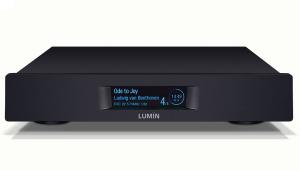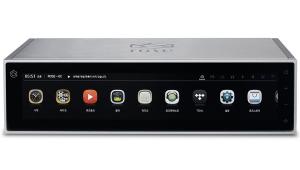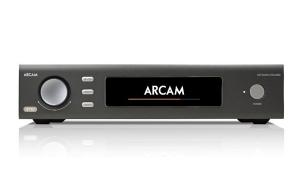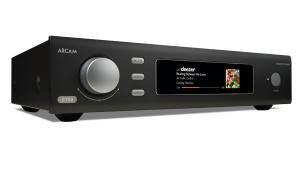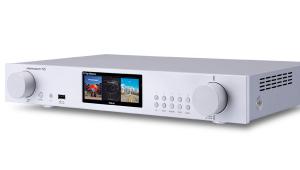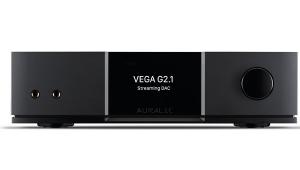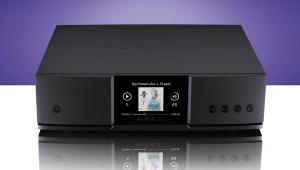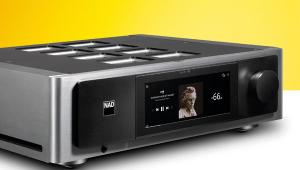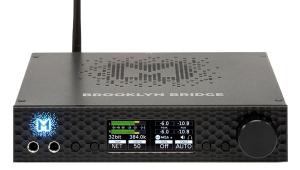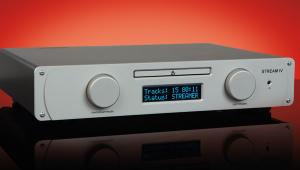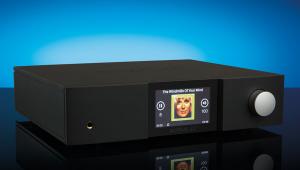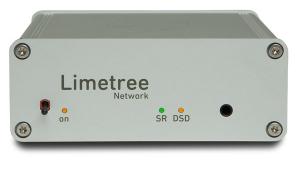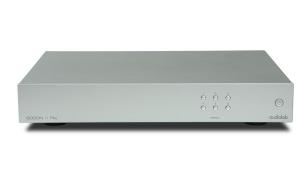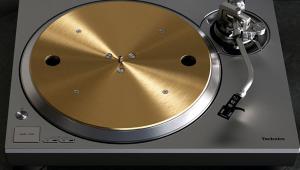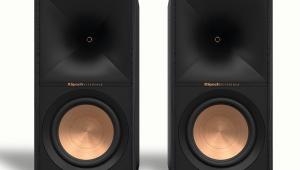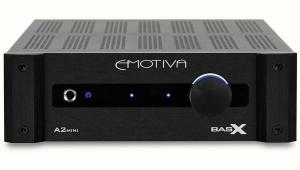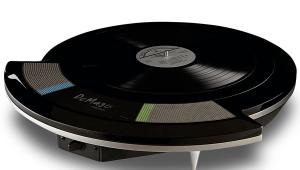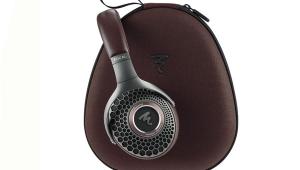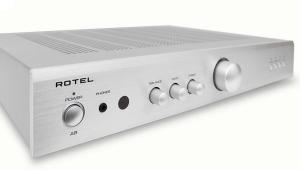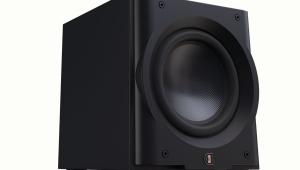QSonix Q105 - £5,000
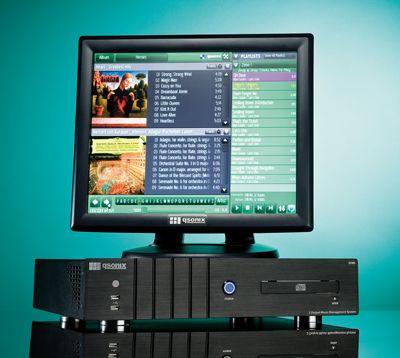
here is a vital question facing any manufacturer of a hard-disk music player. It has nothing to do with what size disks to use or what sort of case to put it in. It is rather more rudimentary, i.e what sort of person is going to buy it?
If the answer is the hard-core audiophile, then the manufacturing task is immediately simplified. Audiophiles will generally be content with a rough edge or two, so long as the musical output is exemplary. They will put up with an interface that is a tad clunky, provided that the music sounds first rate.
The so-called ‘average’ music lover is a much trickier customer because he/she will want good, if not great sound as well as smooth operation with a user interface that is near telepathic in its straightforwardness.In other words, a machine that will satisfy every type of potential buyer: one that mixes superb sound with super-slick operation.
Computer-basedQsonix feels that it has the answer with its powerful and high-performance music management system, the Q105. This turnkey device, so claims the company, caters for all manner of people, from casual music lovers to devoted audiophiles with their extensive music libraries. Although the Q105 can be purchased with one of two touch screens, we opted for the substantial 431.8 millimetres (17-inch) version. This connects to the main unit, which takes care of all the necessary CD ripping and storage through an adaptable, RapidRun single-cable system.
Switching the unit on, we were first aware of the sound made by the fan. Although this measured below 60dB and was not horribly intrusive, it did warrant further investigation. Inside the enclosure there is a small ATX motherboard, with a generously sized Zalman heat-sink/fan cooling the CPU (Central Processing Unit) barely 50mm away from a smaller Arctic case fan. This sits next to a 300-watt Sparkle switched-mode power supply, which has its own fan.
If you are thinking that that is a whole lotta coolin’ goin’ on and wonder what else inside the box is generating Therms, the answer is not a great deal. There’s a Sony NEC optical drive and, alongside it, a Western Digital 500GB hard disk, designed specifically for use in streaming environments. For some reason, both drives use old-fashioned PATA rather than SATA connections. At least, however, they use modern rounded cables rather than the older, airflow restricting ribbons.
Other than that, there’s the separately encased audio DAC/amplifier circuitry housed above the main motherboard, but that was still cool after several hours of playing.
TouchscreenAlthough this is a computer-based device, it certainly doesn’t feel like one. Turn on the main unit by pushing a button on its fascia and the whole shebang comes to life without any arcane boot-up screens, user-intervention or unfathomable fanfares. In fact, it simply switches on reasonably quickly, putting one in mind of other conventional electronic appliances.
Connections on the unit are simple and straightforward. There are two USB (Universal Serial Bus) ports on the fascia; one could be used to plug in a mouse as an alternative to touching the screen. To the rear you will find an ethernet port, two more USBs, connections for the touchscreen, as well as an S/PDIF digital output and two analogue audio outputs.
As one might expect, the ripping procedure is equally simple: insert the disc and the display asks if you want to rip the disc. Touch the Yes button and ripping begins. Very swiftly it completes the task, the unit accessing cover art and metadata from the internet for its library.
You can, of course, alter the format in which you rip: there’s a choice of WAV (Waveform Audio File Format), Lossless and compressed WMA (Windows Media Audio) and MP3. These offer capacities on the 500GB drive of around 800 uncompressed CDs, or more if you choose to use compression. There is no requirement to stick with one format all of the time, of course, and you can import other file types, such as FLAC (Free Lossless Audio Codec) through the USB port or network connection.
Warm-upInitially the Qsonix does not seem to be an especially transparent device and its presentation leans towards being rather cloying and euphonic: a touch too close to an old-school valve amplifier. We left it to warm up over a weekend, during which time it updated its software to add a couple of worthwhile facilities, one of them the ability to rip to WAV. This made the previous ‘best’ rip to WMA Lossless an option that we could then ignore if we so chose. We did and things immediately improved. A few days to come up to operating temperature never does solid-state equipment any harm and working with WAV files is immeasurably better than the unrefined sounding WMA files.
Listening to a WMA of Van Morrison (a much-loved favourite performer), we weren’t impressed by the timbre of his voice. While he is no honey-toned crooner, he certainly should not sound like a bellicose market trader with acute streptococcal pharyngitis – even on his live albums. Listening subsequently to a WAV rip of his A Night in San Francisco Live, he sounds as though he has made a complete recovery.
The dynamics of the 16-bit, 44.1kHz recording are also significantly better on the WAV, with fine gradations in level that have not been apparent before. The dynamic shading of the WMA could be likened more to that of an on/off switch: loud or soft with little differentiation in between. More importantly, though, Morrison’s rigorously drilled band sounds slicker and more enthusiastic in its playing.
Rendering the 16/44 WAV rip of the Tori Amos American Girl Posse album after its warm-through, the Qsonix sounds faster and its note shape is much better defined. That said, the presentation retains a degree of warmth that ensures that it never becomes clinical.
Regardless, we still feel there is potentially more in the way of openness and transparency to come. That had to wait until we imported some higher resolution recordings, including the Dawn Langstroth 24-bit/96kHz album Highwire. Now the music is more open and communicative. Langstroth’s voice escapes more easily from the speakers and her band occupies the acoustic space behind her with a greater sense of authority and substance. Distinct and not-in-the-least subtle musical benefits also emerge on the 24-bit/96kHz recording of the Jerry Garcia, Dave Grisman and Tony Rice acoustic jam session The Pizza Tapes. Through the Q105, music grabs and holds your attention making it difficult to do anything other than relish the performance.
Rewarding performerOverall, the Q105 appears to be most content when handling acoustic music and rendering better quality recordings. Crisply defined leading edges (of the sort that an acoustic guitar produces when played with a plectrum) are impressive, while the clarity that comes with good 24-bit recordings seems to enliven the smooth, slightly relaxed performance of the device. Equally, though, it savours the beautifully recorded 16-bit/44.1kHz rip of Lambchop’s Is A Woman, producing rewarding results with regular CD albums.
The Q105 seems to thrive when the recording has space around the performers. And it’s far from disapproving too, especially when a recording fails to reach the highest standards of audio quality.
LIKE: The ease of use in every respect is extraordinary
DISLIKE: Tends to encourage you to listen mainly to better recordings
WE SAY: Very acceptable, the Q105 is a direct descendant of the custom-install-oriented Q110
DETAILS
PRODUCT: Qsonix Q105
ORIGIN: USA
TYPE: Music management system
WEIGHT: 12.25kg (not including touch screen)
DIMENSIONS: (WxHxD) 430x 100x406mm (not including touchscreen)
FEATURES:
• Outstandingly straightforward graphical user interface
• Q105 can be linked to a TV display and then driven with a mouse or by remote control
• Highly robust, fuss-free operating system for user/family friendliness
• Easy back-up to external USB drive
DISTRIBUTOR: Absolute Sounds
TELEPHONE: 020 8971 3909
WEBSITE: Qsonix.com
 |
Inside this month's issue:
Ruark R610 music system and Sabre-R standmount speakers, PMC twenty.23i Active, floorstanders, English Acoustics Downton preamplifier, Bluesound NODE ICON preamp/streamer, Ortofon Concorde Music Blue MM cartridge and much, much more
|
